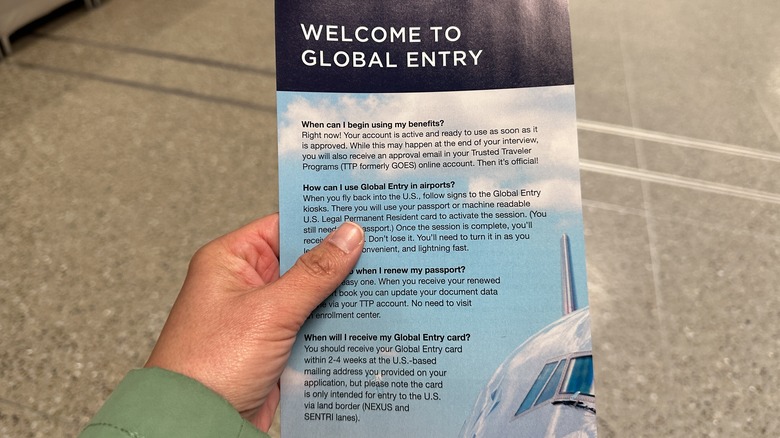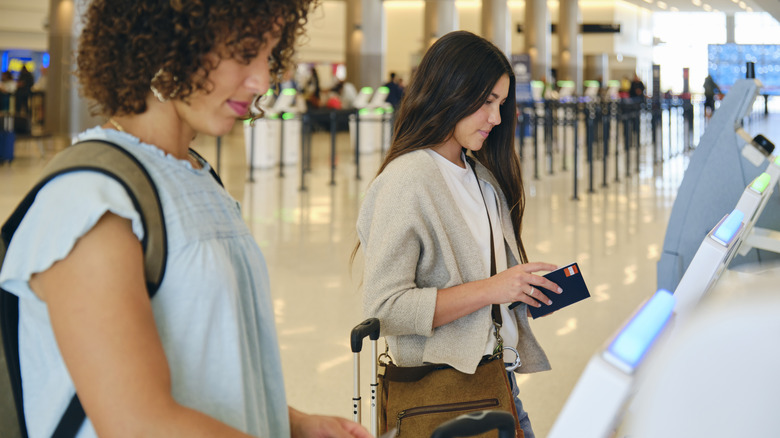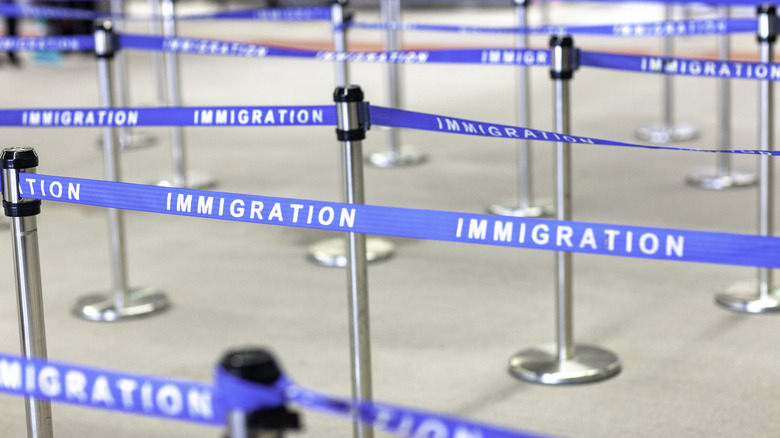What Is Global Entry And Is It A Worthwhile Buy Before Your Next Flight?
Teleportation remains a futuristic dream, and until it becomes reality, we must navigate the hectic, stressful experience of airports. Encountering a grumpy TSA agent can heighten anxiety, but the bigger challenge is the seemingly endless, slow-moving security lines, particularly during peak travel seasons. Fortunately, there's a loophole in this madness — enrolling in expedited travel programs like TSA PreCheck, CLEAR, and Global Entry. Many travelers found that the secret to getting through the TSA as fast as possible is through CLEAR, while others swear that the best way to skip long airline security lines is by signing up for TSA PreCheck. But for those who globe-trot more than they stay home, Global Entry might be best for you.
To the uninitiated, Global Entry is an initiative of the U.S. Customs and Border Protection (CBP) that offers pre-approved, low-risk travelers a quicker re-entry into the United States following a trip abroad. With Global Entry, you can bypass long immigration and customs lines, significantly easing the stress of re-entry after long flights. Simply go through the brief processing via an electronic kiosk, take your picture, scan your passport and fingerprints, and you're nearly on your way. While everyone else is still waiting to talk to an immigration officer, you could be halfway home — or at least getting a head start in claiming your luggage at the carousel.
The best part? A Global Entry membership automatically includes TSA PreCheck benefits, allowing you to cut lines at security before any domestic and international flight, too.
What to know about the Global Entry application process
With great convenience comes a great price, and that price comes in the form of a fairly meticulous application process. For starters, Global Entry doesn't come cheap. You have to shell out $100 to apply, with rates climbing to $120 come October 2024. The silver lining is that this fee is reimbursable through an eligible credit card, and that membership lasts for five years.
Eligibility is also somewhat exclusive. To qualify for application in the first place, you must be a U.S. citizen, a U.S. lawful permanent resident, or a citizen of certain countries, including the United Kingdom, Germany, Singapore, and South Korea. It's also important to note that the TSA PreCheck benefits can only be enjoyed by U.S. citizens and lawful permanent residents.
To apply, you must create a Trusted Travelers Program account and complete a detailed Global Entry application form, which is quite a lengthy questionnaire, asking you for information like your physical characteristics, address, employment history, and a log of your past travel. All these will then be used for a background check. After submission, you'll wait to receive conditional approval, and only then will you be eligible to schedule an in-person interview at any of the Global Entry Enrollment Centers. However, that conditional approval is not a guarantee that you will pass the interview. Additionally, you must schedule your interview within 24 months of receiving conditional approval and complete it within a total of 730 days.
You might have to wait a long time for Global Entry approval
Another thing to be wary of in the Global Entry application process is the waiting game. According to the CBP website, you're looking at a wait time of six to eight months to process your application, but anecdotal stories say otherwise. Some Reddit users have complained about their applications being under pending review for nearly a year. If this happens, you may want to give them a call at their hotline or shoot them an email.
Waiting for conditional approval is perhaps the hardest part, though. Once you have it, you may already schedule an interview. But in case you're also having a hard time securing a timely slot, there's a plan B: Enrollment on Arrival (EoA), which allows you to be interviewed by an immigration officer at a participating airport after landing from an international trip. Generally, you'll only need to present your passport or green card and proof of residence. You'll also have to go through the interview, which is more or less just a verification of what you've indicated on your application form, and then biometrics. If all goes well, you'll be a proud Global Entry member with your very own Known Traveler Number (KTN).
The other downside to all this? Privacy concerns. "[This] could have some pretty dire consequences, collectively and in the long term, should this information ever be misused," John Lipford, professor of tourism at Grand Valley State University, told National Geographic.


